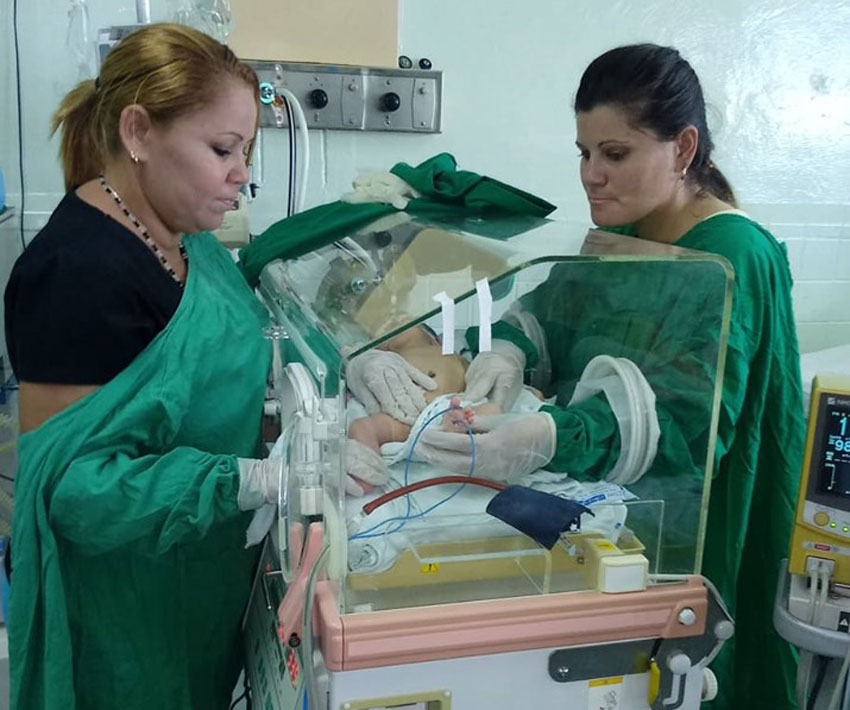
To achieve a rate of 5.0 deaths per 1,000 live births, Cuba has maintained its commitment to maternal-infant health care, even in the most difficult times
Cuba has maintained a great commitment to children's health, even in the most difficult moments for the nation, a task that has required, and requires, much effort, sacrifice, and dedication from thousands of professionals, who work in the country's maternal-infant care services and approach all difficulties and setbacks with determination.
This is why the risk of death during the first year of life is low on the Island. This is the commitment of entire multidisciplinary teams capable of overcoming the greatest challenges, thanks to the political will and support of our government.
Preliminary data, provided by the Medical Records and Health Statistics Directorate, indicate that this past year, born in Cuba were 109,707 children, 6,626 less than the previous year, with an infant mortality rate of 5.0 deaths per 1,000 live births.
Dr. Noemí Causa Palma, director of medical care at the Ministry of Public Health (Minsap), told Granma that we continue to be among the 35 countries with the lowest infant mortality rate and among the first in the region.
The main factors contributing to infant mortality, she added, were related to complications associated with premature birth and intrauterine growth retardation (IUGR), and despite efforts made in the care of pregnant women and newborns, and additional measures adopted, it was not possible to reduce their impact on infant mortality.
It should be noted that for the third consecutive year, the infant mortality rate due to congenital malformations was 0.8 deaths per 1,000 live births. The provinces of Cienfuegos, Sancti Spíritus and the Isle of Youth special municipality ended the year with no deaths from this cause.
This indicator is the best in our region of the Americas and is the result of the work carried out by community genetic services, the development of the national medical genetics network and the national program for the prevention of congenital defects and genetic diseases, Dr. Causa explained.
It is also significant that in 2019 there were no reported maternal deaths from postpartum hemorrhage, a persistent problem in developing countries and an achievement for Cuba, the result of multidisciplinary work carried out over the past three years.
Essential objectives in maternal-infant health care for 2020, the doctor reported, include increasing multisectoral work to reduce teenage pregnancy and risk factors faced by women of childbearing age, such as obesity, hypertension and diabetes mellitus, among others.
Efforts will also be focused on strengthening the monitoring of pregnant women at high risk during their prenatal care in order to detect retarded intrauterine growth and hypertensive disorders in a timely fashion, and prevent pre-term deliveries.
In the case of neonatal services, she added, efforts will be intensified to continue to increase newborn survival rates.
Similarly, health promotion and educational actions will continue to be expanded through the mass media, directed toward women of childbearing age, their partners and family members, in relation to the importance of taking folic acid to prevent congenital disorders, the prevention of sexually transmitted infections, health care for chronic diseases and pregnancy, the promotion of breastfeeding, and the prevention of accidents and community-acquired infections.
PRINCIPAL INDICATORS
-The preschool mortality rate - from 1 to 4 years of age - in 2019 increased from 3.0 to 3.5 per 10,000 inhabitants of that age, the main causes being accidents, acute respiratory infections and malignant tumors.
-The survival rate of children under 5 years of age to the fifth year of life is 99.3%. This indicator has exceeded 99 % for the last 20 years.
-The school-age mortality rate - from 5 to 14 - remained at 2.0 per 10,000 inhabitants in this age range.
-The perinatal mortality rate was reduced from 8.3 to 8.0, primarily by reducing late fetal deaths.
-The total maternal mortality rate was reduced from 43.8 per 100,000 live births in 2018 to 37.4 in 2019, with 10 fewer deaths.
-Direct maternal mortality was reduced from 27.5 to 23.7 and indirect maternal mortality from 16.3 to 13.7.
-Through the program serving infertile couples, more than 6,000 pregnancies were achieved, 2,000 more than last year. In the provincial service centers, six of ten couples assisted achieved pregnancies. In the Regional High Technology Centers, located in the provinces of Havana (two), Cienfuegos and Holguín, more than 200 pregnancies were conceived for the first time, using advanced assisted reproduction techniques.
- A merit for our country and for the National Public Health System was the ratification, by the World Health Organization last September, of our status as a country free of mother-to-child transmission of HIV and congenital syphilis, granted to Cuba in 2015, as the first country in the world.
-In 2019, vaccination coverage of over 98% was guaranteed, protecting the child population against 13 diseases.
-Additionally, through the end of 2019, some 510 cochlear implants have been performed, since the beginning of this program. (Granma)






